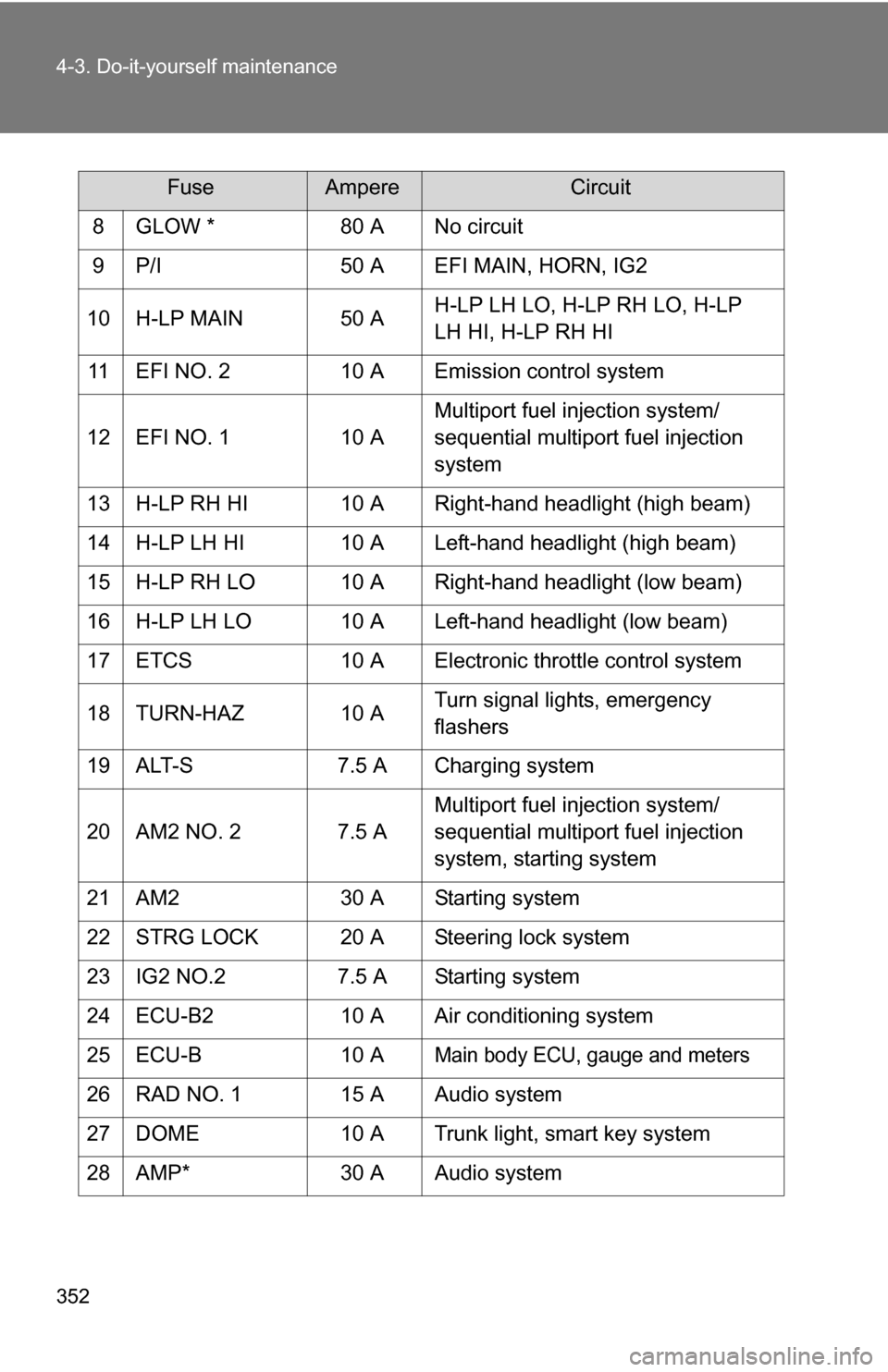Page 352 of 468

352 4-3. Do-it-yourself maintenance
8 GLOW *80 A No circuit
9 P/I 50 A EFI MAIN, HORN, IG2
10 H-LP MAIN 50 A H-LP LH LO, H-LP RH LO, H-LP
LH HI, H-LP RH HI
11 EFI NO. 2 10 A Emission control system
12 EFI NO. 1 10 AMultiport fuel injection system/
sequential multiport fuel injection
system
13 H-LP RH HI 10 A Right-hand headlight (high beam)
14 H-LP LH HI 10 A Left-hand headlight (high beam)
15 H-LP RH LO 10 A Right-hand headlight (low beam)
16 H-LP LH LO 10 A Left-hand headlight (low beam)
17 ETCS 10 A Electronic throttle control system
18 TURN-HAZ 10 A Turn signal lights, emergency
flashers
19 ALT-S 7.5 A Charging system
20 AM2 NO. 2 7.5 A Multiport fuel injection system/
sequential multiport fuel injection
system, starting system
21 AM2 30 A Starting system
22 STRG LOCK 20 A Steering lock system
23 IG2 NO.2 7.5 A Starting system
24 ECU-B2 10 A Air conditioning system
25 ECU-B 10 A
Main body ECU, gauge and meters
26 RAD NO. 1 15 A Audio system
27 DOME 10 A Trunk light, smart key system
28 AMP* 30 A Audio system
FuseAmpereCircuit
Page 357 of 468
357
4-3. Do-it-yourself maintenance
4
Maintenance and care
Light bulbs
You may replace the following bulbs yourself. The difficulty level of
replacement varies depending on the bulb. If necessary bulb
replacement seems difficult to perfor m, contact your Toyota dealer.
For more information about replacing other light bulbs, contact your
Toyota dealer.
■ Prepare a replacement light bulb.
Check the wattage of the light bulb being replaced. ( P. 427)
■ Front bulb locations
Headlight high beam
Headlight low beamFront turn signal and parking lights
Front fog lights (if equipped)
Front side marker lights
Page 358 of 468
358 4-3. Do-it-yourself maintenance
■Rear bulb locations
Stop/tail and rear side marker lights Rear turn signal lights
Back-up lights
License plate lights
Page 361 of 468
361
4-3. Do-it-yourself maintenance
4
Maintenance and care
Unplug the bulb while depress-
ing the lock release.
■ Front turn signal/parking lights and front side marker lights
Turn the steering wheel away from the side being worked on.
This will move the tire to provide more room.
Remove the fender liner clips.STEP4
STEP1
STEP2
Page 362 of 468
362 4-3. Do-it-yourself maintenance
Partly remove the fender liner
and turn the bulb base counter-
clockwise.Front side marker light
Front turn signal/parking light
Remove the light bulb. Front side marker light
Front turn signal/parking lightSTEP3
STEP4
Page 363 of 468
363
4-3. Do-it-yourself maintenance
4
Maintenance and care
■
Stop/tail and rear side marker lights, and rear turn signal
lights
Open the trunk lid.
Remove the luggage trim cover
clips. Partly remove the luggage
trim cover.
Type A Turn the bulb base counterclock-
wise.
Stop/tail and rear side marker
light
Rear turn signal light
Remove the light bulb. Stop/tail and rear side marker
light
Rear turn signal light
STEP1
STEP2
STEP3
STEP4
Page 364 of 468
364 4-3. Do-it-yourself maintenance
Type BTurn the bulb base counterclock-
wise.
Stop/tail and rear side marker
light
Rear turn signal light
Remove the light bulb. Stop/tail and rear side marker
light
Rear turn signal light
■ Back-up light
Open the trunk lid and remove
the cover.
Turn the bulb base counterclock-
wise.
STEP3
STEP4
STEP1
STEP2
Page 382 of 468

382 5-2. Steps to take in an emergency
■When a tire is replaced with a spare tire
The compact spare tire is not equipped with the tire pressure warning
valve and transmitter. If a tire goes flat, the tire pressure warning light will
not turn off even though the flat tire is replaced with the spare tire.
Replace the spare tire with the repair ed tire and adjust the proper tire
inflation pressure. The ti re pressure warning light will turn off after a few
minutes.
■If the tire pressure warning system is inoperative
The tire pressure warning system will be disabled in the following condi-
tions:
(When the condition becomes normal, the system will work properly.)
●If tires not equipped with tire pressure warning valves and transmit-
ters are used.
●If the ID code on the tire pressure warning valves and transmitters is
not registered in the tire pressure warning computer.
●If the tire inflation pressure is 73 psi (500 kPa, 5.1 kgf/cm2 or bar) or
higher.
The tire pressure warning system may be disabled in the following condi-
tions:
(When the condition becomes normal, the system will work properly.)
●If electronic devices or facilities using similar radio wave frequencies
are nearby.
●If a radio set at similar frequencies is in use in the vehicle.
●If a window tint that affects the radio wave signals is installed.
●If there is a lot of snow or ice on the vehicle, in particular around the
wheels or wheel housings.
●If non-genuine Toyota wheels are used. (Even if you use Toyota
wheels, the tire pressu re warning system may not work properly with
some types of tires.)
●If tire chains are used.